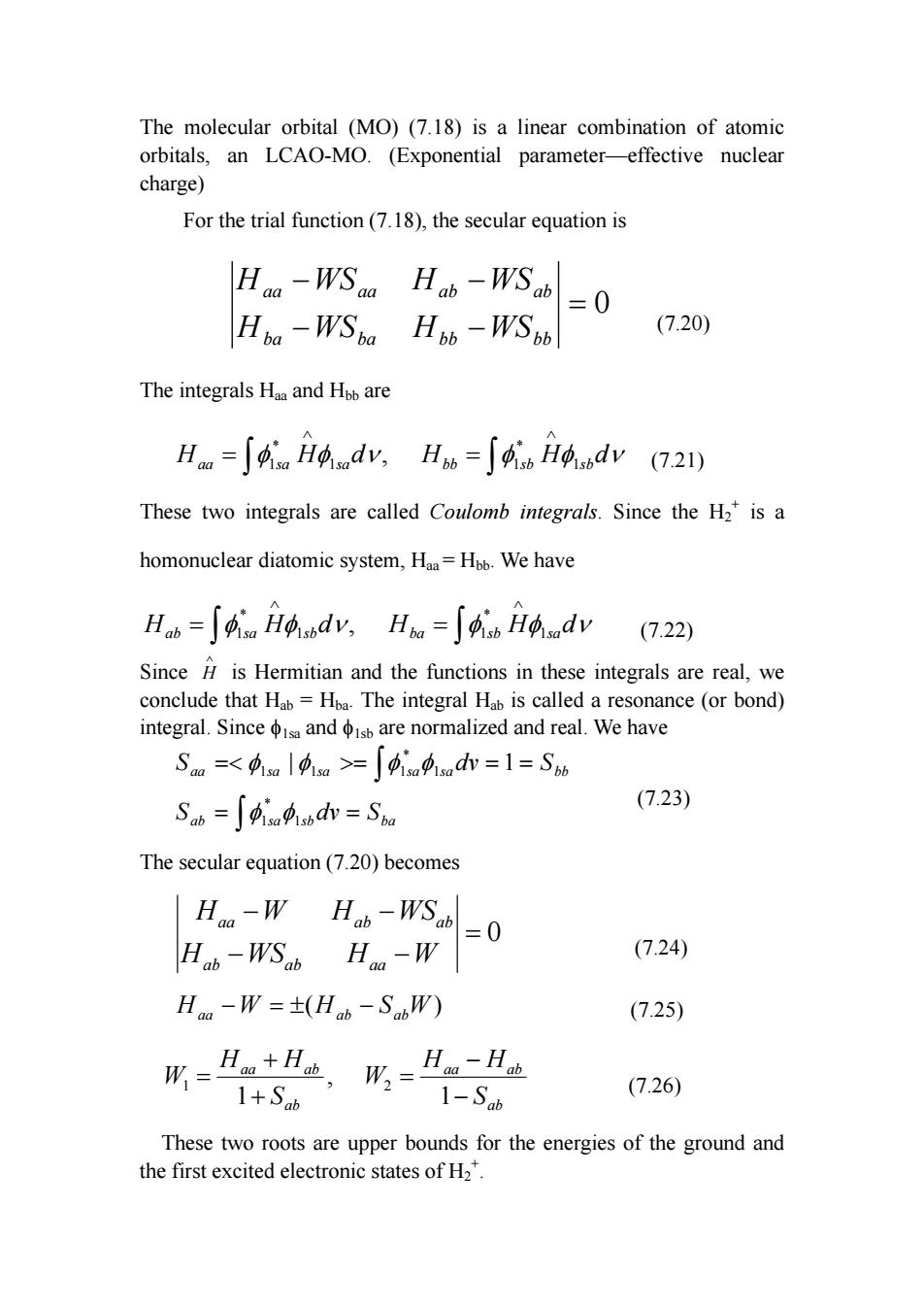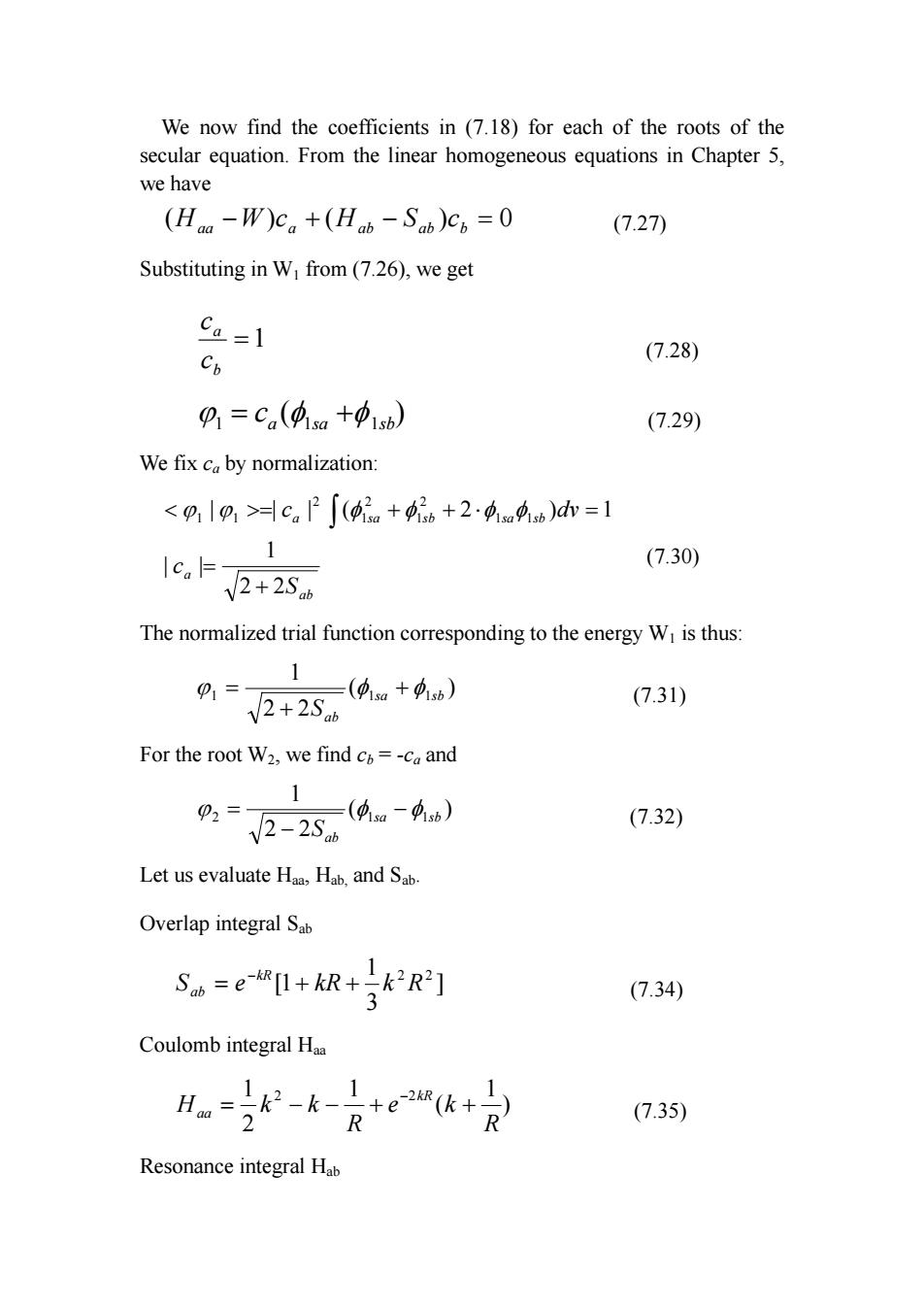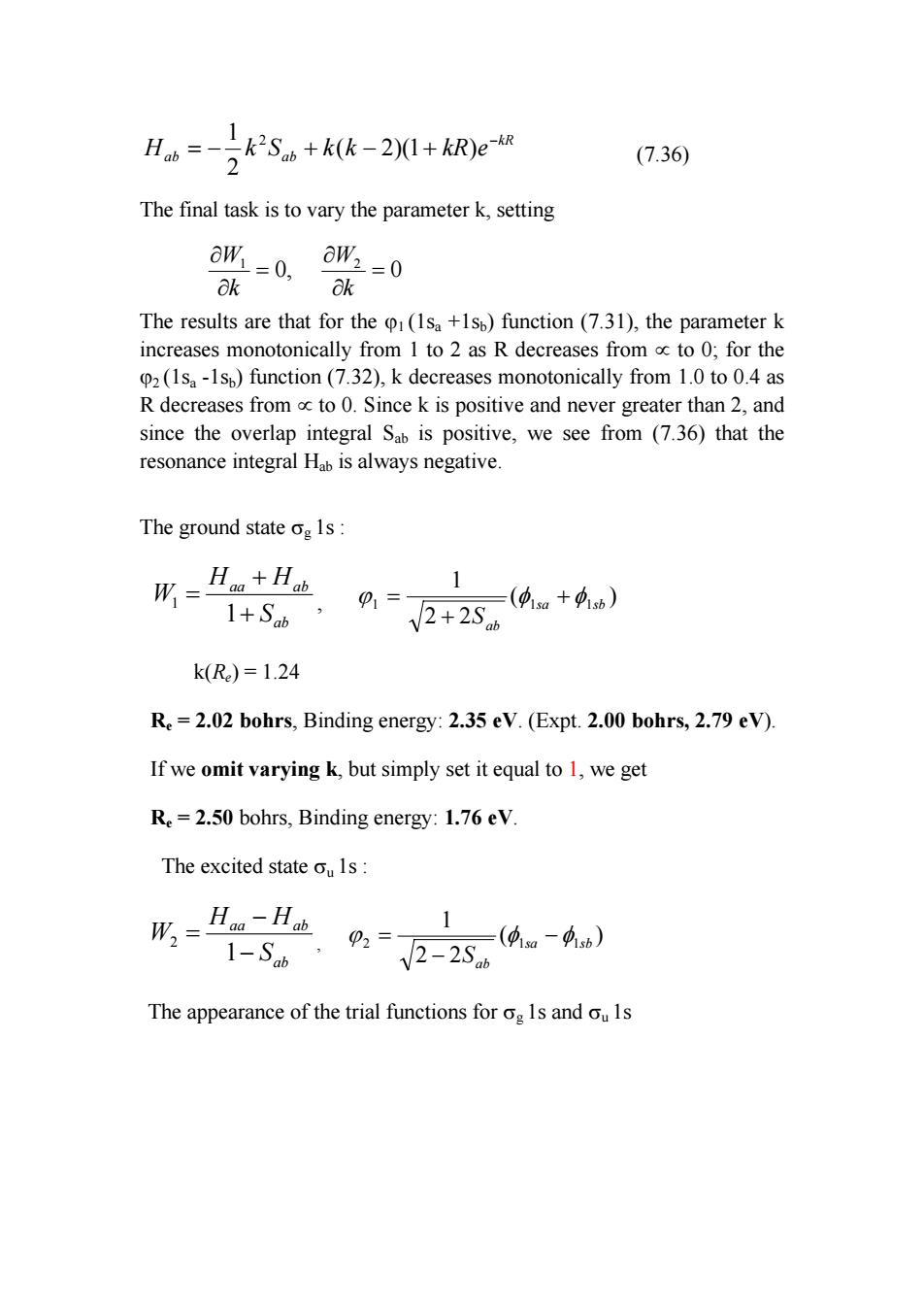
The molecular orbital (MO)(7.18)is a linear combination of atomic orbitals,an LCAO-MO.(Exponential parameter-effective nuclear charge) For the trial function(7.18),the secular equation is H-WS.H-WS=0 Hba-WSba Hob-WSpb (7.20) The integrals Haa and Hob are Hnm=∫4nH4ndk,Hb=∫4ibH4dy(I.21)) These two integrals are called Coulomb integrals.Since the H2'is a homonuclear diatomic system,Han=Hob.We have Hb=∫gaH4bdy,Ha=∫4bH4dy(7.22) Since is Hermitian and the functions in these integrals are real,we conclude that Hab=Hpa.The integral Hab,is called a resonance (or bond) integral.Sinceand are normalized and real.We have Sa=<4La|中a>=pi中1adh=1=Sb Sab=∫gin中i6dr=Sba (7.23) The secular equation(7.20)becomes H-W Ha-WS.=0 Hab -WSab Hoo-W (7.24) Hoo -W=(Hob-SabW) (7.25) 所-月tH4,所-二H 1+Sab 1-Sh (7.26) These two roots are upper bounds for the energies of the ground and the first excited electronic states of H2
The molecular orbital (MO) (7.18) is a linear combination of atomic orbitals, an LCAO-MO. (Exponential parameter—effective nuclear charge) For the trial function (7.18), the secular equation is = 0 − − − − ba ba bb bb aa aa ab ab H WS H WS H WS H WS (7.20) The integrals Haa and Hbb are Haa φ sa Hφ sadν Hbb φ sb Hφ1sbdν * 1 1 * 1 , ∫ ∫ ∧ ∧ = = (7.21) These two integrals are called Coulomb integrals. Since the H2 + is a homonuclear diatomic system, Haa = Hbb. We have Hab φ sa Hφ sbdν Hba φ sb Hφ1sadν * 1 1 * 1 , ∫ ∫ ∧ ∧ = = (7.22) Since ∧ H is Hermitian and the functions in these integrals are real, we conclude that Hab = Hba. The integral Hab is called a resonance (or bond) integral. Since φ1sa and φ1sb are normalized and real. We have ab sa sb ba aa sa sa sa sa bb S dv S S dv S = = =< >= = = ∫ ∫ 1 * 1 1 * 1 | 1 1 1 φ φ φ φ φ φ (7.23) The secular equation (7.20) becomes = 0 − − − − H WS H W H W H WS ab ab aa aa ab ab (7.24) H W (H S W ) aa − = ± ab − ab (7.25) ab aa ab ab aa ab S H H W S H H W − − = + + = 1 , 1 1 2 (7.26) These two roots are upper bounds for the energies of the ground and the first excited electronic states of H2 +

We now find the coefficients in (7.18)for each of the roots of the secular equation.From the linear homogeneous equations in Chapter 5, we have (H-W)c+(Hh-S)c=0 (7.27 Substituting in W from(7.26),we get Ca=l Co (7.28) =Ca(Osa +oisb) (7.29) We fix ca by normalization: <g,9,>cP∫(2++244h)d=1 Ico (7.30) 2+28 The normalized trial function corresponding to the energy W is thus: 1 01= =(9a+中b) V2+2S (7.31) For the root W2,we find c=-co and 1 0=2-2 =(4La-1b) (7.32) Let us evaluate Haa,Hab,and Sab Overlap integral Sat Sw=e1+R+片2R] (7.34) Coulomb integral Haa (7.35) Resonance integral Hab
We now find the coefficients in (7.18) for each of the roots of the secular equation. From the linear homogeneous equations in Chapter 5, we have ( − ) + ( − ) = 0 aa a ab ab b H W c H S c (7.27) Substituting in W1 from (7.26), we get = 1 b a c c (7.28) ( ) 1 a 1sa 1sb ϕ = c φ +φ (7.29) We fix ca by normalization: ab a a sa sb sa sb S c c dv 2 2 1 | | | | | ( 2 ) 1 1 1 2 1 2 1 2 1 1 + = < >= + + ⋅ = ∫ ϕ ϕ φ φ φ φ (7.30) The normalized trial function corresponding to the energy W1 is thus: ( ) 2 2 1 1 1sa 1sb ab S ϕ φ + φ + = (7.31) For the root W2, we find cb = -ca and ( ) 2 2 1 2 1sa 1sb ab S ϕ φ −φ − = (7.32) Let us evaluate Haa, Hab, and Sab. Overlap integral Sab ] 3 1 [1 2 2 S e kR k R kR ab = + + − (7.34) Coulomb integral Haa ) 1 ( 1 2 1 2 2 R e k R H k k kR aa = − − + + − (7.35) Resonance integral Hab

H=号25+6k-2+Re" (7.36) The final task is to vary the parameter k,setting =0,a亚=0 k ak The results are that for the (Is+1sp)function(7.31),the parameter k increases monotonically from I to 2 as R decreases from to 0;for the 2(1s -1sp)function(7.32),k decreases monotonically from 1.0 to 0.4 as R decreases from to 0.Since k is positive and never greater than 2,and since the overlap integral Sab is positive,we see from (7.36)that the resonance integral Hb is always negative. The ground state o1s m=H。+H幽 1 1+Sab 01= V2+2S =(91a+41b) k(R)=1.24 Re=2.02 bohrs,Binding energy:2.35 eV.(Expt.2.00 bohrs,2.79 eV). If we omit varying k,but simply set it equal to 1,we get Re=2.50 bohrs,Binding energy:1.76 eV The excited state ou 1s m=H。-Hb V2-254.4) 1 1-Sab The appearance of the trial functions for og Is and ouls
kR ab ab H k S k k kR e− = − + ( − 2)(1+ ) 2 1 2 (7.36) The final task is to vary the parameter k, setting 0, 0 1 2 = ∂ ∂ = ∂ ∂ k W k W The results are that for the ϕ1 (1sa +1sb) function (7.31), the parameter k increases monotonically from 1 to 2 as R decreases from ∝ to 0; for the ϕ2 (1sa -1sb) function (7.32), k decreases monotonically from 1.0 to 0.4 as R decreases from ∝ to 0. Since k is positive and never greater than 2, and since the overlap integral Sab is positive, we see from (7.36) that the resonance integral Hab is always negative. The ground state σg 1s : ab aa ab S H H W + + = 1 1 , ( ) 2 2 1 1 1sa 1sb ab S ϕ φ + φ + = k(Re) = 1.24 Re = 2.02 bohrs, Binding energy: 2.35 eV. (Expt. 2.00 bohrs, 2.79 eV). If we omit varying k, but simply set it equal to 1, we get Re = 2.50 bohrs, Binding energy: 1.76 eV. The excited state σu 1s : ab aa ab S H H W − − = 1 2 , ( ) 2 2 1 2 1sa 1sb ab S ϕ φ −φ − = The appearance of the trial functions for σg 1s and σu 1s